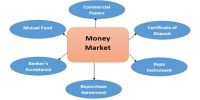The money market is usually defined as the market for marketable short-term debt instruments and the bond market as the market for marketable long-term debt instruments. However, as hinted at above, it is our opinion that the money market is far more than this. It is comprised of the following markets:
- The primary markets that bring together the supply of retail and wholesale short-term funds and the demand for wholesale and retail short-term funds (marketable and non-marketable).
- The secondary market in which existing marketable short-term instruments are traded.
- The creation of new money (deposits) and the financial assets that lead to this (loans in the form of NMD and MD securities).
- The central bank-to-bank interbank market (cb2b IBM) and the bank-to- central bank interbank market (b2cd IBM) where monetary policy is played out and interest rates have their genesis (i.e. where repo is implemented).
- The bank-to-bank interbank market (b2b IBM) where the repo rate has its secondary impact, i.e. on the interbank rate.
- The money market derivative markets (= an addendum).
This is why we define the money market as comprising the entire short-term debt market. Another strong reason is that short-term interest rates are not primarily “discovered” in the short-term marketable debt market; rather they are discovered in the non-marketable debt market (starting with the repo rate, which then influences the interbank rate, then the bank call rates and so on…), and marketable short-term debt rates then take their cues from these rates.













